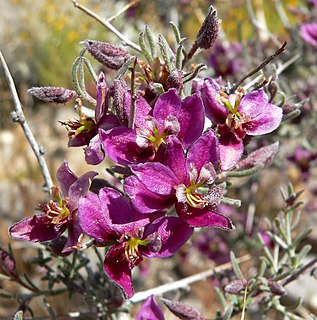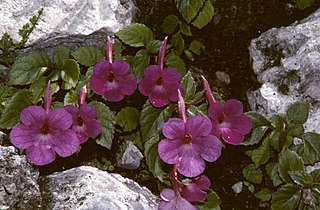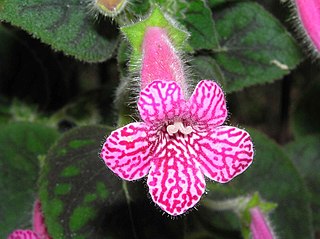
Potentilla is a genus containing over 300 species of annual, biennial and perennial herbaceous flowering plants in the rose family, Rosaceae. They are usually called cinquefoils in English, but they have also been called five fingers and silverweeds. Potentilla are generally only found throughout the northern continents of the world (holarctic), though some may even be found in montane biomes of the New Guinea Highlands. Several other cinquefoils formerly included here are now separated in distinct genera - notably the popular garden shrub P. fruticosa, now Dasiphora fruticosa.

Tagetes is a genus of annual or perennial, mostly herbaceous plants in the sunflower family Asteraceae. They are among several groups of plants known in English as marigolds. The genus Tagetes was described by Carl Linnaeus in 1753.

Potentilla erecta is a herbaceous perennial plant belonging to the rose family (Rosaceae).

Moenchia erecta, the erect chickweed or upright chickweed, is a small annual plant in the family Caryophyllaceae. It can grow to over 10 cm in height, but it is usually smaller. It has blue-green glaucous leaves, and small, delicate white flowers. The sepals are longer than the petals, green and bordered in white. The plant is a common pasture weed native to Europe. It has been introduced elsewhere, including Australia and western North America, but it is not particularly invasive or competitive.

Tagetes erecta, the Mexican marigold or Aztec marigold, is a species of flowering plant in the genus Tagetes native to Mexico. Despite its being native to the Americas, it is often called African marigold. In Mexico, this plant is found in the wild in the states of México, Michoacán, Puebla, and Veracruz.

Achimenes is a genus of about 25 species of tropical and subtropical rhizomatous perennial herbs in the flowering plant family Gesneriaceae. They have a multitude of common names such as magic flowers, widow's tears, Cupid's bower, or hot water plant.

Populus tremula, commonly called aspen, common aspen, Eurasian aspen, European aspen, or quaking aspen, is a species of poplar native to cool temperate regions of Europe and Asia, from Iceland and the British Isles east to Kamchatka, north to inside the Arctic Circle in Scandinavia and northern Russia, and south to central Spain, Turkey, the Tian Shan, North Korea, and northern Japan. It also occurs at one site in northwest Africa in Algeria. In the south of its range, it occurs at high altitudes in mountains.

Berula erecta, known as lesser water-parsnip or cutleaf waterparsnip or narrow-leaved water-parsnip, is a member of the carrot family. Growing to around 1 m (3 ft) tall, it is found in or by water. It is widespread across much of Europe, Asia, Australia, and North America.

Krameria erecta is a species of rhatany known by several common names, including Pima rhatany, purple heather, and littleleaf rhatany. It is native to the southwestern United States and northern Mexico, where it grows in dry areas such as desert flats and chaparral slopes. This is a small, tangled shrub under a meter in height with blunt, thorny branches covered in silky hairs and fuzzy linear leaves. The shrub flowers in the spring and again in the fall during wetter years. The showy flower has four or five bright pink cup-shaped sepals and usually five smaller, triangular petals which are pink with green bases. The three upper petals are held erect and the lower two are glandular structures next to the ovary. Next to these are four curving stamens. The fruit is a furry heart-shaped body covered in pink spines. It reproduces by seed. This species and others in its genus are root parasites, tapping the tissues of nearby plants for nutrients, especially water. This helps it survive in soil that is almost totally dry.

Duranta erecta is a species of flowering shrub in the verbena family Verbenaceae, native from Mexico to South America and the Caribbean. It is widely cultivated as an ornamental plant in tropical and subtropical gardens throughout the world, and has become naturalized in many places. Common names include golden dewdrop, pigeon berry, and skyflower.
Monardella linoides is a species of flowering plant in the mint family known by the common name flaxleaf monardella.

Cionura is a genus of perennial plants found through the Mediterranean regions, the South and Eastern parts of the Balkan peninsula and Asia Minor to Afghanistan. It contains only one known species, Cionura erecta.

Cryptostylis erecta, commonly known as the bonnet orchid or tartan tongue orchid , is an orchid endemic to south eastern Australia. A small and common plant, it has dark green lance-shaped to egg-shaped leaves and up to twelve greenish flowers with a large, bonnet-like or hood-like, lilac-coloured labellum with a network of purple veins.

Boerhavia erecta, commonly known as the erect spiderling or the erect boerhavia, is one of more than 100 species in the genus Boerhavia L. Boerhavia erecta is native to the United States, Mexico, Central America and western South America, but now is cosmopolitan in tropical and subtropical regions. In Africa its distribution extends from West Africa, eastwards to Somalia and down to South Africa. It has recently been found in parts of Madagascar and Réunion. In Asia, it occurs in India, Java, Malaysia, the Philippines, China and the Ryukyu Islands.

Achimenes grandiflora(Schltdl.) DC. is a plant species in the genus Achimenes, family Gesneriaceae. It is native to Mexico and Central America, growing in mountainous regions from Chihuahua to Nicaragua. It is cultivated as an ornamental in other places because of its showy purple flowers.
Plectorrhiza erecta , commonly known as the upright tangle orchid, is an epiphytic or lithophytic orchid that has many coarse, cord-like roots, many bright green leaves and up to five yellowish orange, cup-shaped flowers with purplish blotches. It grows close to the ground on fibrous barked plants and only occurs on Lord Howe Island.

Kohleria amabilis, the tree gloxinia, is a species of the flowering plant belonging to the family Gesneriaceae.

Solidago erecta is a species of goldenrod known by the common names showy goldenrod and slender goldenrod. It is native to the eastern United States, from Massachusetts west to Indiana, and south as far as Georgia and Mississippi.
Grindelia subalpina, the subalpine gumweed, is a North American species of flowering plants in the Astereae tribe of the daisy family.

Pterostylis erecta, commonly known as the upright maroonhood, is a species of orchid endemic to eastern Australia. Flowering plants have a rosette of four to seven stalked, dark green, crinkled leaves and a greenish to reddish-brown flower with a gap between the petals and lateral sepals. It occurs in New South Wales and south-eastern Queensland.

















